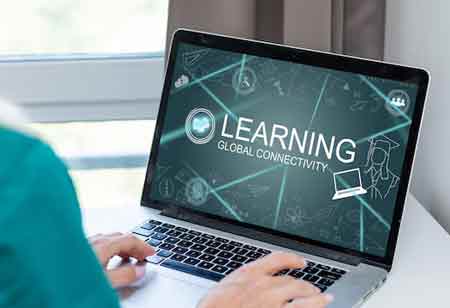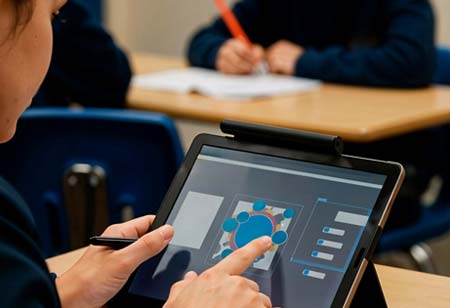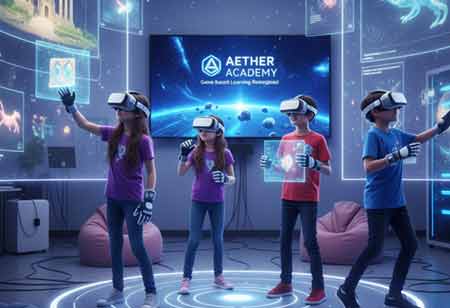THANK YOU FOR SUBSCRIBING
Be first to read the latest tech news, Industry Leader's Insights, and CIO interviews of medium and large enterprises exclusively from Education Technology Insights
Transforming Education: The Impact of New Technologies
Educational technology is revolutionizing teaching and learning through immersive experiences, adaptive platforms, gamification, and blockchain, but responsible and ethical use is crucial.

By
Education Technology Insights | Tuesday, November 25, 2025
Stay ahead of the industry with exclusive feature stories on the top companies, expert insights and the latest news delivered straight to your inbox. Subscribe today.
FREMONT, CA: In an age where technology pervades every area of our lives, it's no surprise that education is changing dramatically. With the implementation of cutting-edge technologies and innovations, the learning landscape is rapidly shifting.
The latest trends shaping the future of educational technology
Immersive Learning Experiences: Virtual reality (VR) and augmented reality (AR) are revolutionizing education by providing immersive learning experiences. Imagine students exploring ancient civilizations in VR, dissecting virtual frogs, or conducting chemistry experiments in a simulated lab environment. These technologies bridge the gap between theoretical concepts and real-world applications, making learning more engaging and memorable.
Adaptive Learning Platforms: Personalized learning is gaining traction with the advent of adaptive learning platforms. These platforms use artificial intelligence (AI) algorithms to analyze students' learning patterns and tailor educational content to their needs. By adapting the pace, difficulty level, and content based on each student's progress, these platforms ensure that no one is left behind and everyone reaches their full potential.
Gamification: Gamification is transforming education by incorporating game elements into learning experiences. From earning points and badges to competing with peers, gamified learning motivates students and makes learning fun. Educational games enhance engagement and foster critical thinking, problem-solving, and collaboration skills.
Microlearning: With attention spans dwindling in the digital age, microlearning has emerged as an effective educational strategy. Microlearning involves delivering content in small, bite-sized chunks that are easy to digest. Whether through short videos, interactive quizzes, or infographics, microlearning enables students to learn on the go and at their own pace, maximizing retention and comprehension.
Blockchain in Education: Blockchain technology is disrupting the traditional credentialing system by providing secure and transparent verification of academic credentials. With blockchain, educational records such as degrees, certificates, and diplomas can be securely stored and accessed, eliminating the risk of fraud and enhancing the credibility of qualifications.
Collaborative Learning Tools: Collaboration is a cornerstone of 21st-century learning, and educational technology facilitates collaboration like never before. Students can collaborate with peers and educators regardless of their physical location, from cloud-based document-sharing platforms to virtual whiteboards and video conferencing tools. These tools promote teamwork, communication, and global connectivity.
Artificial Intelligence in Assessment: AI-powered assessment tools are revolutionizing student evaluation. Through natural language processing and machine learning algorithms, these tools can analyze written responses, provide instant feedback, and identify areas where students may need additional support. AI-driven assessment not only saves time for educators but also enables more personalized and insightful feedback for students.
Robotics and Coding: Robotics and coding are increasingly integrated into educational curricula to equip students with essential 21st-century skills. From programming robots to performing specific tasks to coding applications and games, students learn computational thinking, problem-solving, and creativity in a hands-on and interactive way.
Internet of Things (IoT) in Education: The Internet of Things (IoT) is reshaping the classroom environment by connecting devices and collecting data to optimize learning experiences. IoT-enabled smart classrooms can automatically adjust lighting, temperature, and seating arrangements to create an ideal learning environment. Moreover, IoT devices can track student attendance, monitor engagement levels, and provide real-time insights to educators.
Ethical and Responsible Use of Technology: As technology becomes increasingly ubiquitous in education, teaching students about its moral and responsible use is essential. From digital citizenship and online safety to privacy concerns and information literacy, educators must equip students with the knowledge and skills to navigate the digital world responsibly.







